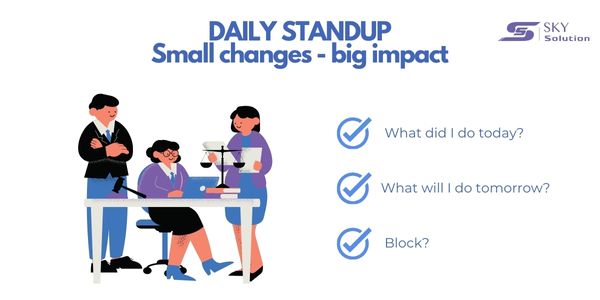Daily Standup in Scrum is a management method that most leaders use in the business operations process because it helps them capture the situation and issues in each member’s work. What exactly is Daily Standup? How do you conduct it effectively? This article below will provide you with the most comprehensive overview of operating Daily Standup in business management.
I. What is Daily Standup in Scrum?
These days, most software teams apply Agile, especially the Scrum process, to increase flexibility and efficiency. In Scrum, the work is divided into short Sprints, usually lasting from 1 to 4 weeks, with the goal of completing specific products after each Sprint. One important activity in Scrum is the Daily Standup – a 15-minute daily meeting where members quickly share their progress, plans, and challenges. This is a great way to keep the entire team aligned and ready to handle any arising issues.
I’ve been running Daily Standups for a team of more than 10 people for about 3 months and have found no effectiveness. It’s extremely time-consuming. Specifically, people arrive at the office at 8:30 am. every day, and the first thing they do is write their own Daily.
What did I do yesterday? All the tasks a member completed yesterday.
What will I do today? Plan today’s to-do list.
Block? Is there anything preventing a member from completing their tasks (e.g., waiting for results from another member, technical difficulties without a solution, etc.)?

Each person takes about 15 minutes to do this on Jira. Note that Jira doesn’t have a built-in feature for writing dailies (at least as of the time I’m writing this blog on 08/10/2024), so you’ll need to install a plugin. I recommend a handy plugin called Daily Standups for Jira—just enough for what you need, not excessive or too basic. I would arrive at the office at 9am every day and start the daily meeting. Everything happened in the correct sequence!
Writing daily reports helps team members become more aware of what they are doing, giving their day’s work a clearer direction. But I still feel like something is off:
- Meetings always last at least 30 minutes, taking up over 6% of the team’s workday. Sometimes it lasts more than an hour
- Everyone speaks individually, while others sit there feeling confused, or even exhausted, as the reports from other members have no relevance to what they are working on.
- As the meeting leader, because I don’t have time to review and summarize everyone’s daily reports, I tend to be quite passive, unable to control or synthesize the information properly to make informed decisions.
It was a total waste of time and effort with no results, so I decided to cut out daily standups from the process and let people run their own, proactively communicating when issues arise—“Daily Standups are nonsense!” However, this was a major trade-off, as team members lost the tool to monitor their daily progress and detect issues in time.

II. How to conduct an effective Daily Standup
To solve this situation, I consulted with a PM, and below are some small changes I made to salvage the situation:
- Encourage employees to write their Daily Note at the end of the day, 15 minutes before leaving work.
- Answer three questions in the Daily Note: What did I do today? What will I do tomorrow? Block?
- Require everyone to note the percentage of work completed that day.
- In the morning, before the meeting starts, the PM must read through all the daily notes from the previous day and summarize the information.
- During the meeting, the PM will raise issues and provide conclusions about the members’ work for that day.

III. Benefits of Daily Standup
- Using the Daily Note has greatly helped me in operating my organization.
- All meetings now take place within 15 minutes or less. Previously, each member had to present their own Daily Note, but now the PM proactively summarizes, captures the situation, and quickly offers solutions.
- Writing the daily from the previous day also helps employees work more efficiently the next day because they have extra time each evening to automatically connect the information and make the issues more transparent.
IV. Conclusion
In general, Daily Standup is a powerful tool if used correctly. Even a small change in the daily process can bring great results in maintaining the team’s alignment and focus. Remember, the key is not to rigidly follow the process, but to continuously adjust and optimize it to suit the reality of your team’s work. If done right, Daily Standup will become an indispensable part of helping your team achieve its goals more quickly and effectively.

